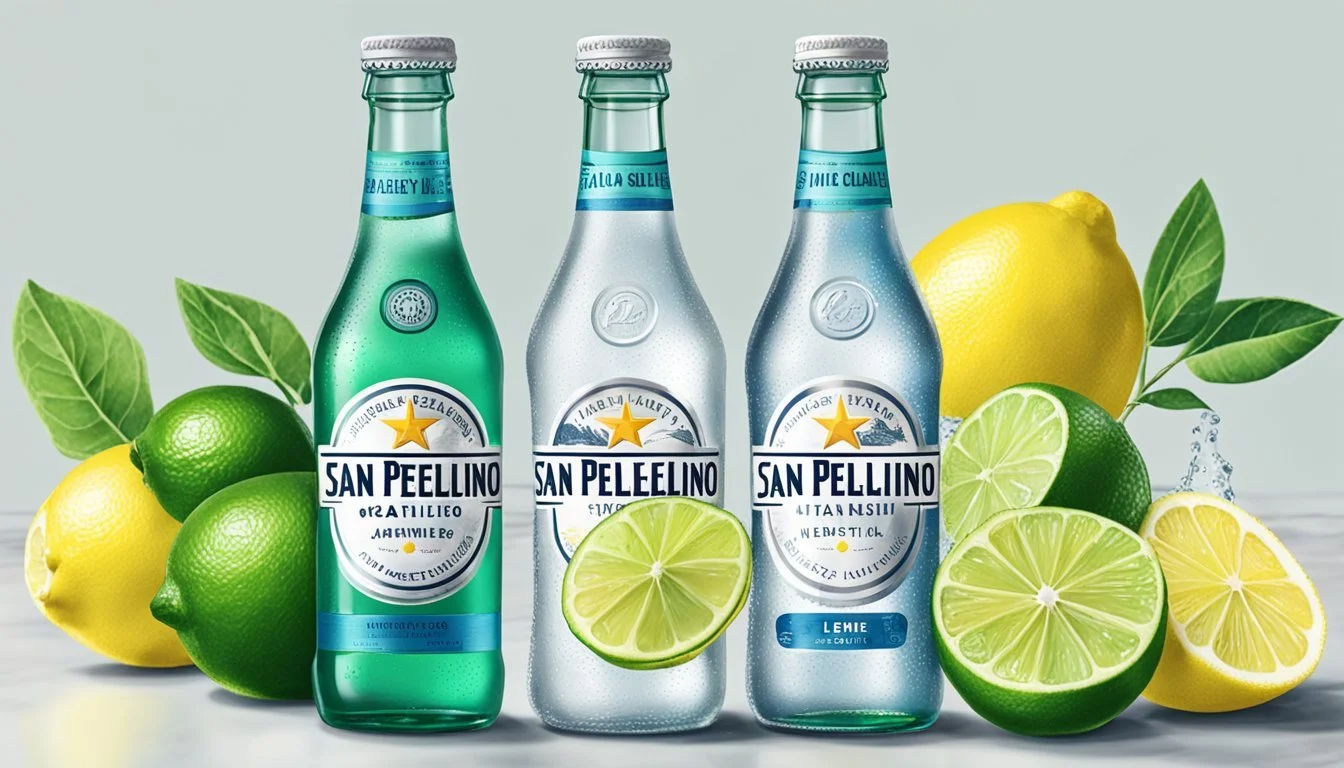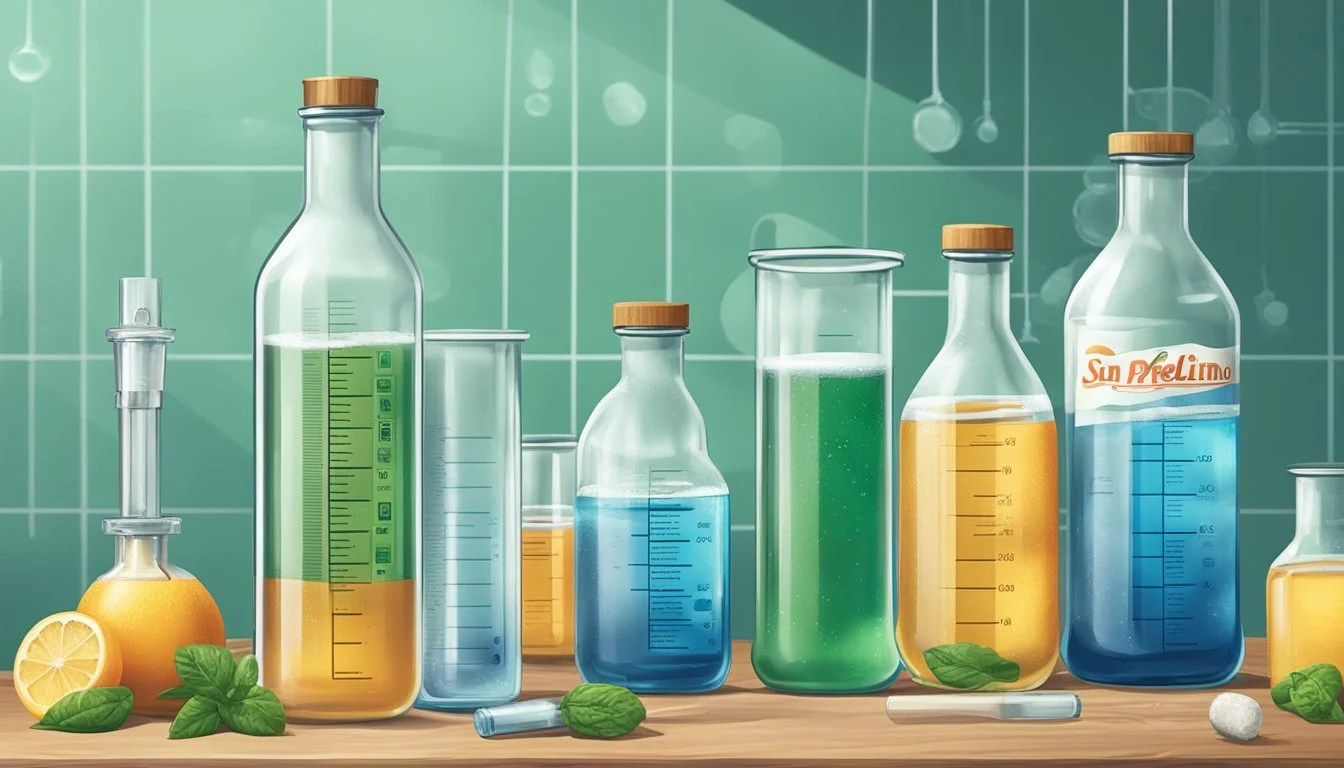San Pellegrino vs. Tahoe
Which Bottled Water is Better? An Expert Comparison
When choosing between bottled waters, San Pellegrino and Tahoe stand out as two popular options, each with its unique qualities. San Pellegrino, known for its slightly higher fizz and classic mineral taste, offers a distinct experience that many sparkling water enthusiasts prefer. In taste tests, the extra carbonation of San Pellegrino often edges it ahead of other brands, making it a favorite for those who enjoy a more robust sparkling water.
Tahoe, on the other hand, has built a reputation around purity and a clean, crisp taste. Sourced from the pristine waters of Lake Tahoe, this bottled water brand emphasizes minimal processing to deliver a natural and refreshing drinking experience. Many consumers appreciate Tahoe for its simplicity and the assurance that they are consuming water that is close to its natural state.
For those comparing these two brands, San Pellegrino delivers a flavorful and fizzy punch, while Tahoe offers a pure and refreshing option. Whether you prioritize a sparkling sensation or the purity of natural spring water, this comparison will help you decide which bottled water aligns best with your preferences.
Understanding Bottled Water
Bottled water comes in various forms, each with unique origins, treatment processes, and regulatory standards. Understanding its history, types, and regulations help consumers make informed choices.
History and Development of Bottled Water
The bottled water industry has roots stretching back centuries. In the 18th century, mineral waters from natural springs began to be bottled for their perceived health benefits. Companies like San Pellegrino have been producing mineral water since 1899.
The 20th century saw the expansion of bottled water due to advancements in bottling technology. Brands began to emphasize purity and taste. Today, it’s a global industry with various options catering to different preferences and needs.
Different Types of Bottled Water
Mineral Water: Contains naturally occurring minerals and is sourced from protected underground reservoirs. San Pellegrino is a prime example, rich in minerals like calcium and magnesium.
Spring Water: Drawn from natural springs, often touted for its purity. Brands like Acqua Panna traverse natural aquifers before bottling.
Purified Water: Undergoes processes like reverse osmosis or distillation to remove impurities and contaminants, ensuring high purity levels.
Artesian Water, Sparkling Water: Add variety to the market with distinctive properties, from effervescence to unique mineral content.
Labelling and Regulations
Bottled water labeling and regulations ensure consumer safety and product transparency. In the U.S., the Food and Drug Administration (FDA) oversees bottled water standards, mandating that labels accurately reflect the water's source and treatment.
The Environmental Protection Agency (EPA) regulates public drinking water, ensuring it meets rigorous quality standards. Bottled water must also comply with these safety standards, though it’s regulated differently from tap water.
Key labeling terms include “mineral water” for waters with consistent mineral content and “spring water” for those originating from natural springs. Compliance with FDA and EPA regulations guarantees that bottled water is safe and healthful for consumption.
Defining the Contenders
San Pellegrino and Tahoe Spring Water each boast unique characteristics and histories. San Pellegrino originates from the Italian Alps and is known for its mineral content, while Tahoe Spring Water is sourced from pristine locations in California.
San Pellegrino: An Overview
San Pellegrino is an iconic brand that sources its water from a natural spring in the Italian Alps. This pristine source infuses the water with beneficial minerals such as potassium, calcium, sodium, and magnesium.
San Pellegrino's sparkling water includes added carbon dioxide to maintain its distinct fizz and mineral balance. The brand's reputation extends beyond its refreshing qualities; it is often associated with elegance and luxury, making it a popular choice in upscale dining environments.
Tahoe Spring Water: Brand Profile
Tahoe Spring Water is sourced from California's Sierra Nevada region, known for its pure and clean water. This brand prides itself on drawing from deep, protected springs, ensuring minimal contamination and maintaining natural mineral content.
Unlike some competitors, Tahoe Spring Water focuses on preserving the water's natural state without additional carbonation or artificial enhancements. Its clean and crisp taste reflects the quality of its source, making it a favorite among health-conscious consumers who prefer non-sparkling options.
These details capture the essence of San Pellegrino and Tahoe Spring Water, highlighting their unique qualities and origins.
Chemical and Physical Analysis
San Pellegrino and Tahoe bottled waters show marked differences in terms of mineral content, carbonation, and health implications of their mineral compositions.
Mineral Content Comparison
San Pellegrino is renowned for its rich mineral composition, featuring sodium, magnesium, calcium, and potassium. Specifically, it has higher levels of magnesium and calcium compared to many other bottled waters.
Tahoe water, on the other hand, typically has a lower mineral content. This makes it milder in flavor and potentially more suitable for individuals on low-sodium diets.
Mineral San Pellegrino (mg/L) Tahoe (mg/L) Sodium 33 5 Magnesium 56 10 Calcium 208 15 Potassium 2 1
The Science of Carbonation
San Pellegrino is a sparkling water, infused with carbon dioxide to create light, effervescent bubbles. This carbonation not only adds a distinct mouthfeel but also affects the perceived taste, enhancing some mineral flavors while softening others.
Tahoe water comes as still water, without carbonation. This means it does not have the bubbly texture that San Pellegrino offers, making it a simpler choice for those who prefer non-carbonated beverages.
The presence of carbon dioxide in sparkling water can have minor effects on digestion and may sometimes be perceived as more refreshing due to the texture provided by the bubbles.
Health Implications of Minerals
The high calcium content in San Pellegrino makes it an excellent choice for supporting bone health. Magnesium aids in muscle function and energy production, while sodium and potassium are crucial for fluid balance and nerve transmission.
Tahoe’s lower mineral content, especially its low sodium levels, might be preferred by individuals with certain health conditions, such as hypertension or kidney problems, where limiting sodium intake is beneficial.
Both waters provide potassium, albeit in small amounts, which is important for cardiovascular health and overall cellular function.
In conclusion, while both San Pellegrino and Tahoe waters have distinct characteristics, their chemical and physical properties cater to different consumer needs and preferences.
Aesthetic Qualities
Choosing between San Pellegrino and Tahoe bottled water can often come down to the finer points of taste, texture, and presentation, each offering a unique experience.
Taste and Palate Experience
San Pellegrino's taste is renowned for its crisp and slightly bitter notes. The sparkling mineral water offers a refreshing flavor, appreciated by many with refined palates. Sommeliers and culinary experts often recommend it as a pairing for meals due to its balanced mineral content.
Tahoe, on the other hand, provides a clean and neutral taste. Its spring water has minimal mineral interference, making it a popular choice for those who prefer a more subdued palate experience. This difference in taste profiles can significantly influence consumer preference.
Texture and Effervescence
San Pellegrino is well-known for its distinct texture and effervescence. The bubbles are fine, providing a sophisticated mouthfeel that many find pleasing. This characteristic fizz is a key distinguishing factor, setting it apart from regular bottled waters.
Tahoe, being still spring water, has a smooth texture without carbonation. The absence of bubbles results in a softer drinking experience. Those who enjoy sipping water without the effervescence will likely find Tahoe more appealing. Hence, the texture plays a crucial role in the sensory experience of each brand.
Presentation and Packaging
San Pellegrino’s presentation is iconic, with its signature green glass bottles and elegant labeling. The use of glass bottles not only adds a premium feel but also preserves the effervescence better than plastic. This attention to packaging details enhances the overall perception of quality.
Tahoe opts for a more straightforward packaging approach, typically utilizing clear plastic bottles. The design is functional and focuses on practicality. While it may not offer the same premium aesthetic as glass, it serves the purpose well for everyday hydration needs. This difference underscores the brands' distinct market positioning.
Environmental and Ethical Considerations
San Pellegrino and Tahoe bottled water brands differ in their environmental and ethical approaches, focusing on their water sourcing, the impact of their bottling processes, and the brand initiatives they undertake.
Source Sustainability
San Pellegrino sources its water from a well-protected natural spring in San Pellegrino Terme, Italy. This source is renowned for its mineral-rich content, which is protected by a government-monitored aquifer.
Tahoe, on the other hand, uses water that originates from the Sierra Nevada Mountains, tapping into a pristine and renewable natural source. Both brands stress the importance of maintaining the purity and sustainability of their water sources, but differ in their geographical and operational approaches to conservation.
Bottling Process Impact
San Pellegrino's bottling process emphasizes the use of glass bottles for their premium products, reducing plastic waste. However, they do produce some plastic bottles which contribute to environmental impacts. Their glass bottles are recyclable, aiming to minimize landfill use.
Tahoe follows a strict sustainability protocol, using BPA-free plastic bottles that are fully recyclable. They prioritize eco-friendly manufacturing practices to limit carbon emissions. Though both brands aim to reduce their carbon footprint, the preference of materials used in bottling plays a critical role in their environmental impact.
Brand Initiatives
San Pellegrino has various philanthropic efforts, focusing on water accessibility and community support. Owned by Nestlé, they participate in numerous global initiatives. This includes efforts to enhance water conservation and support sustainable farming.
Tahoe engages in local environmental conservation and educational programs. They sponsor events that promote sustainability and invest in technologies to reduce their industrial footprint. Their initiatives are more regionally focused, yet they still contribute substantially to broader environmental goals.
Consumer Perspectives
Understanding consumer preferences, loyalty, and the accessibility of bottled water brands like San Pellegrino and Tahoe helps highlight why individuals might choose one over the other.
Market Preferences and Trends
Consumers often prioritize taste, health benefits, and the origins of the water when selecting between brands. San Pellegrino, sourced from the Italian Alps, is favored for its distinct mineral composition and slightly sparkling texture. This sets it apart as a premium choice among sparkling water brands.
Tahoe water, known for its pure and refreshing taste, appeals to those who prefer still water sourced from pristine environments. It is also popular among people looking for more budget-friendly options without sacrificing quality.
Brand Loyalty and Community
Brand loyalty plays a significant role in the bottled water market. San Pellegrino has a loyal following, partly due to its alignment with high-end culinary experiences and its strong brand heritage. Many consumers associate San Pellegrino with quality and luxury, which reinforces their preference.
Tahoe, while not as prominent, has built a steady base of loyal consumers through consistent quality and grassroots community engagement. Customers appreciate the brand's commitment to sustainability and local initiatives, creating a sense of shared values.
Availability and Accessibility
Accessibility significantly affects consumer choices. San Pellegrino, available internationally, often features prominently in fine dining establishments, supermarkets, and gourmet stores. Its widespread availability makes it a convenient choice for those seeking premium sparkling water.
Tahoe, though less globally distributed, is readily available in various regional markets and online platforms. Its accessibility in specific regions makes it a popular choice locally, offering consumers a reliable and high-quality alternative to mainstream brands.
By focusing on these aspects, consumers can make informed decisions based on their specific preferences and needs in the bottled water market.
Comparative Market Analysis
San Pellegrino and Tahoe are two prominent brands in the bottled water industry, each adopting unique strategies to capture market share. This analysis will explore their pricing strategies, competitive landscape, and how they maintain their position in the market.
Pricing Strategies
San Pellegrino positions itself as a premium brand, often priced higher due to its Italian origins and perceived quality. It targets consumers willing to pay more for a luxury product. In contrast, Tahoe offers competitive pricing, aiming to attract a broader customer base by providing high-quality water at a more accessible price point.
San Pellegrino's pricing strategy leverages its reputation, while Tahoe focuses on value. San Pellegrino's pricing is strength in exclusivity. Tahoe uses competitive edge in affordability. Both strategies cater to their respective audience segments.
Competitive Brands
San Pellegrino faces stiff competition from other premium brands like Perrier, Fiji, and Acqua Panna. These brands, also positioned as luxury waters, compete on factors such as taste, purity, and brand heritage. Perrier's sparkling variety rivals San Pellegrino's offerings, while Fiji's natural artesian origins appeal to similar consumer preferences.
Tahoe, on the other hand, competes with brands like Essentia, Topo Chico, and Mountain Valley, which focus on providing high-quality water at competitive prices. Tahoe needs to differentiate itself in taste and value to stand out in this crowded market.
Holding Market Share
San Pellegrino maintains its market share through strong brand loyalty and targeted marketing campaigns. Its image as a sophisticated choice for discerning consumers helps it retain a dedicated customer base. Seasonal and limited-edition offerings also keep the brand engaging and fresh.
Tahoe's strategy involves widespread distribution and competitive pricing. By ensuring availability in multiple retail channels and maintaining a consistent product quality, Tahoe retains its market share. Strategic partnerships and promotional deals further enhance its visibility and consumer preference.
San Pellegrino leverages its premium image and heritage, while Tahoe capitalizes on broad accessibility and affordability. Both brands utilize these strategies to secure and expand their market positions.
Recommendations and Conclusions
When comparing San Pellegrino and Tahoe bottled water, several factors should be considered for making an informed choice.
San Pellegrino is well-regarded for its fine bubbles and mineral content, offering a pleasant mouthfeel and compatibility with food. It provides a balanced taste and moderate fizz, making it an enjoyable option for those who appreciate a more refined sparkling water experience.
Core Hydration can be significantly influenced by the type of water consumed. San Pellegrino's mineral content can contribute positively to daily hydration needs, which is essential for maintaining overall well-being.
Tahoe bottled water, less known but still offering quality hydration, primarily focuses on pure, crisp taste akin to high-altitude sources. It usually avoids the carbonation of San Pellegrino, providing a smoother drinking experience.
For health considerations, both options provide clean, safe drinking water. San Pellegrino's mineral enrichment offers slight benefits; however, those who prefer lower mineral content or non-carbonated options might lean towards Tahoe.
Using filtered water at home, especially with reverse osmosis systems, could be an alternative. This method removes impurities and offers another avenue for pure hydration without purchasing bottled water.
When evaluating the bottom line, San Pellegrino may come at a higher price point due to its popularity and imported status. In contrast, Tahoe could be a cost-effective choice if budget constraints are a priority.
Tips for decision-making:
If a refined, mineral-rich sparkling water is desired, San Pellegrino is a strong choice.
For pure, non-carbonated refreshment, consider Tahoe.
Tap water with appropriate filtration offers a sustainable and economical option for daily hydration.
More About San Pellegrino
Acqua Panna vs San Pellegrino: Which Bottled Water is Better?
Boxed Water vs San Pellegrino: Which Bottled Water is Better?
Core Hydration vs San Pellegrino: Which Bottled Water is Better?
Ice Mountain vs San Pellegrino: Which Bottled Water is Better?
Icelandic Glacial vs San Pellegrino: Which Bottled Water is Better?
Just Water vs San Pellegrino: Which Bottled Water is Better?
Mountain Valley Spring Water vs San Pellegrino: Which Bottled Water is Better?
Nestle Pure Life vs San Pellegrino: Which Bottled Water is Better?
Poland Spring vs San Pellegrino: Which Bottled Water is Better?
San Pellegrino vs Alkaline88: Which Bottled Water is Better?
San Pellegrino vs Aqua Carpatica: Which Bottled Water is Better?
San Pellegrino vs Cascade Mountain: Which Bottled Water is Better?
San Pellegrino vs Castle Rock: Which Bottled Water is Better?
San Pellegrino vs CBD Living: Which Bottled Water is Better?
San Pellegrino vs Crystal Geyser: Which Bottled Water is Better?
San Pellegrino vs Crystal Lake: Which Bottled Water is Better?
San Pellegrino vs Essence pH10: Which Bottled Water is Better?
San Pellegrino vs Hawaii Volcanic: Which Bottled Water is Better?
San Pellegrino vs Hawaiian Springs: Which Bottled Water is Better?
San Pellegrino vs Kirkland Signature: Which Bottled Water is Better?
San Pellegrino vs Liquid Death: Which Bottled Water is Better?
San Pellegrino vs Open Water: Which Bottled Water is Better?
San Pellegrino vs Proud Source: Which Bottled Water is Better?
San Pellegrino vs Purely Sedona: Which Bottled Water is Better?
San Pellegrino vs Richard's Rainwater: Which Bottled Water is Better?
San Pellegrino vs Simple Truth: Which Bottled Water is Better?
San Pellegrino vs Smartwater: Which Bottled Water is Better?
San Pellegrino vs Solan de Cabras: Which Bottled Water is Better?
San Pellegrino vs Talking Rain AQA: Which Bottled Water is Better?
San Pellegrino vs Topo Chico: Which Bottled Water is Better?
San Pellegrino vs Weird Water: Which Bottled Water is Better?
San Pellegrino vs Whole Foods 365: Which Bottled Water is Better?
San Pellegrino vs Whole Foods Italian Still Mineral water: Which Bottled Water is Better?
San Pellegrino vs Zephyrhills: Which Bottled Water is Better?








